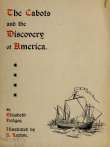You are here
قراءة كتاب The Cabots and the Discovery of America With a Brief Description and History of Brandon Hill, The Site of the Cabot Memorial Tower
تنويه: تعرض هنا نبذة من اول ١٠ صفحات فقط من الكتاب الالكتروني، لقراءة الكتاب كاملا اضغط على الزر “اشتر الآن"

The Cabots and the Discovery of America With a Brief Description and History of Brandon Hill, The Site of the Cabot Memorial Tower

Original
THE CABOTS AND THE DISCOVERY OF AMERICA
With A Brief Description And History Of Brandon Hill, The Site Of The Cabot Memorial Tower.
By Elizabeth Hodges
Illustrated By S. Loxton
London:
1897

Original

Original

Original
CONTENTS
THE CABOTS AND THE DISCOVERY OF AMERICA
THE CABOTS AND THE DISCOVERY OF AMERICA
CHIEF among the attractions of Bristol has been for centuries past the church of St. Mary Redcliffe; while few names on her roll of fame are more widely known than that of the ancient citizen to whom the stately fabric owes so much of its grace and beauty.
And we grudge not the mead of praise. He who gives of his best to the service of God and his fellow men deserves high honour. But, when all is said, the work of William Canynge was as a drop in the ocean compared with that accomplished by the merchant-pilot, his contemporary and probable neighbour. Canynge helped to re-build a church; John Cabot discovered a continent, and secured it for all time to the English-speaking race. Yet the one has been remembered and revered; the other neglected and forgotten. An anomaly, perhaps accounted for by the fact that Bristol has ever been slow to recognise merit outside her borders, and John Cabot was an alien, while the claims of Sebastian, his son, to citizenship are still hotly contested; which is not surprising, as the evidence so far obtainable rests mainly upon the contradictory accounts of Sebastian himself.
To an unprejudiced mind, however, the assertion made by him to his friend Eden in old age, when he had no purpose in view and nothing to gain by it, "that he was borne in Bristowe, and at iiii. yeare ould he was carried with his father to Venice, and so returned agayne to England with his father after certayne years, whereby he was thought to have been



